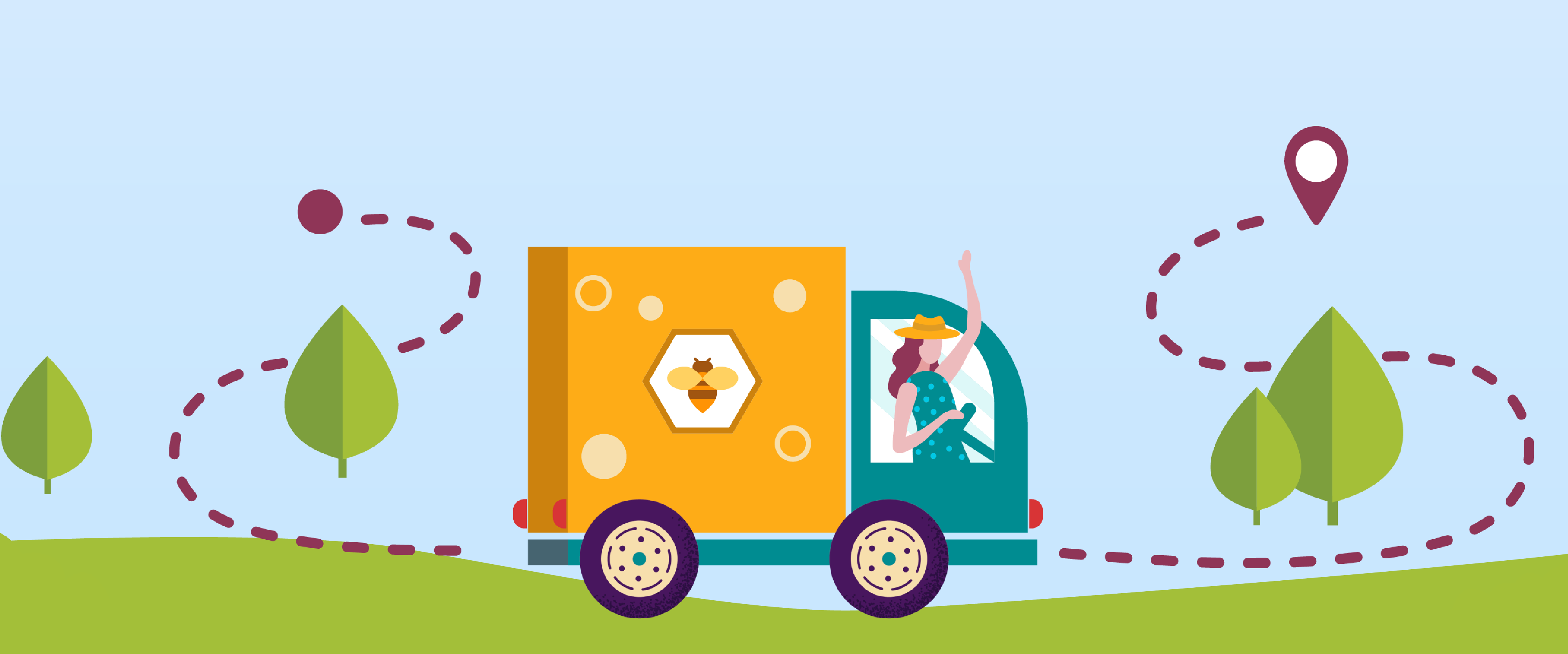OVERVIEW
This module explains how to better understand what entrepreneurship is about.
It shows how to improve self-awareness & what questions should be asked to identify some new solutions to start or further develop an innovative business in rural areas.
It also shares the multiple REWARD case studies of the heroines' experiences to better explain how innovation and start-ups ideas can be adapted and implemented.
LEARNING OBJECTIVES
Knowledge:
You will be able to identify the questions you need to answer as a new or developing business woman, as well as the existing opportunities to further develop your ideas if you are interested in applying solutions in relation to innovation or start-ups.
Skills:
You will develop skills to assess your actual motivation, identify potential opportunities to develop your business, diversify your farming activities or use to a fuller extent the potential of rural cultural heritage.
Competences:
The word “entrepreneur” derives from the French verb “entreprendre” - meaning ‘to undertake’.
- What?
- Who?
- Why?
- What drives you?
- The idea
- Is there still a need to talk specifically about women entrepreneurs?
The concept of “entrepreneurship” is not easy to define. If referring to the FAO we can combine some definitions to better understand it as:
- “a force that mobilises other resources to meet unmet market demand”,
- “the ability to create and build something from practically nothing”,
- “the process of creating value by pulling together a unique package of resources to exploit an opportunity”. (combined definitions of entrepreneurship by Jones and Sakong, 1980; Timmons, 1989; Stevenson, et al., 1985. FAO).
The entrepreneur is a person who either creates new combinations of production factors such as new methods of production, new products, new markets, finds new sources of supply and new organizational forms; or as a person who is willing to take risks; or a person who, by exploiting market opportunities, eliminates disequilibrium between aggregate supply and aggregate demand, or as one who owns and operates a business (Tyson, Petrin, Rogers, 1994, p. 2-3).
The motivation to take action can be extrinsic or intrinsic.

Source: https://elearninginfographics.com/3-types-of-motivation-infographic/
Think carefully about what it is. Understand your own motivations before you get involved; you’ll find yourself more satisfied in the long run. You will also avoid the wrong reasons.
Here are some reasons to become an entrepreneur:
- Flexibility or being your own boss,
- Control of your own decision or the will to make a difference,
- Teamwork,
- Lasting legacy,
- Satisfaction of what you are doing,
- Personal growth and accomplishment,
- Money or financial independence
In addition, ask yourself about personal & business environment. Here are some basic concerns:
- Education: do you need any additional or specific formation(s) to start/ develop your business?
- Local environment features: is there any local authority support or advisory system you could engage with?
- Barriers to entrepreneurship development: are you stigmatized as a person with rural background?
Don’t forget that you can access very good literature and motivation talks for free via internet. For example:
- “Discover Your True North,” by Harvard leadership expert and best-selling author Bill George.
- Watch TED-talks at www.ted.com
An entrepreneurial idea is an idea a person has that can be turned into a business.
Questions for you: What business could I start? What service could I offer?
To turn the idea into a business plan you will need to define:
- Your knowledge, skills and competencies as entrepreneur,
- The goals for your company and an entrepreneurial strategy,
- Your attitude toward social recognition and responsibility,
- Attitude towards property, etc.
Most important skills as an entrepreneur:
- Curiosity
- Time management
- Strategic thinking
- Efficiency
- Resilience
- Networking
- Communication
- Branding
- Sales
- Finance
The concept, characteristics, entrepreneurship motivation, etc. is directly applicable to both men and women. There is no difference in characteristics such as achievement, autonomy, aggression, independence and benevolence between female and male entrepreneurs and no differences were found in risk taking propensity of male and female entrepreneurs. (Hisrich and Brush, 1984).
Research demonstrates women entrepreneurs may do things differently. For example, in comparison to male entrepreneurs, women tend to work more in teams, are less self-centered and personal ego to them is less important than success of the organization or business idea they are pursuing. (FAO, Section I: Entrepreneurship and supporting institutions: an analytical approach; http://www.fao.org/3/W6882e/w6882e02.htm).
BUT, rural women entrepreneurs can encounter many constraints as rural areas tend to be more traditional in regard to the issue of gender. Their self-esteem and managerial skills can be lower when compared to urban women and access to external financial resources more difficult than in urban areas.
TO BETTER UNDERSTAND YOUR MOTIVATION read the REWARD case studies. For example:
► being already a farmer and the need to go further – Hana Hruba, CZ.
► or inheritance – Charlotte Vassant, FR.
S- Specific: is the objective clear? Is it clear what we exactly mean?
M- Measurable: how will we know if we have achieved it? How will we measure our success?
A- Attainable: is it possible to achieve this goal? What do we need to make it attainable?
R- Relevant: Does it deliver wider priorities? Is it worth doing?
T- Time Bound (In a time frame with a deadline): by when are we going to achieve this.
www.toolshero.com/personal-development/smart-goals/
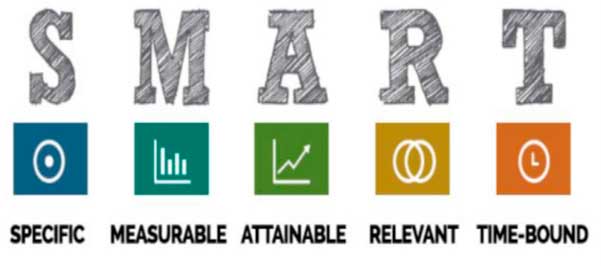
You can also take a look at an important source of information on entrepreneurship opportunities and entrepreneurial ecosystems : the Global Entrepreneurship Monitor (GEM) began in 1999 as a joint research project between Babson College (USA) and London Business School (UK). The consortium has become the richest source of reliable information on the state of entrepreneurship and entrepreneurial ecosystems across the globe, publishing not only the GEM Global Report annually, but also a range of national and special topic reports each year. More information: www.gemconsortium.org
Question for you:
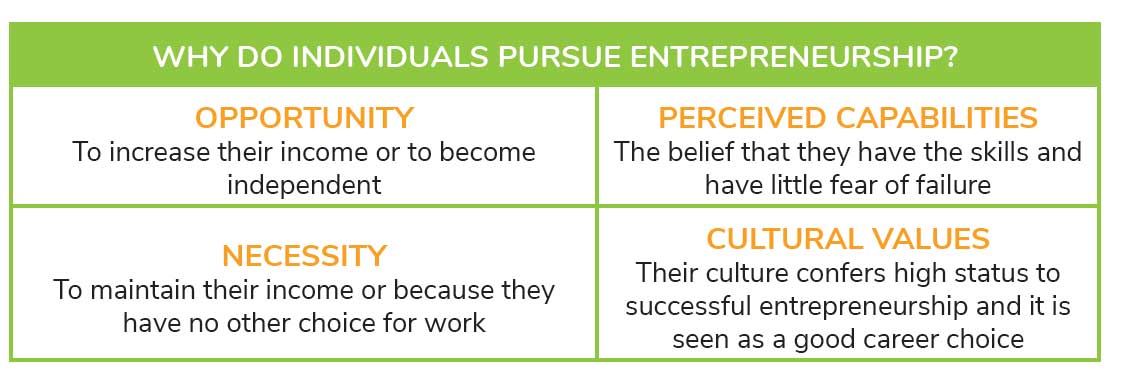
www.gemconsortium.org/about/gem/5
In coaching there is a GROW model that can help you develop and reach your goals. Through certain questions you can explore the different stages to better identify and reach your objectives.
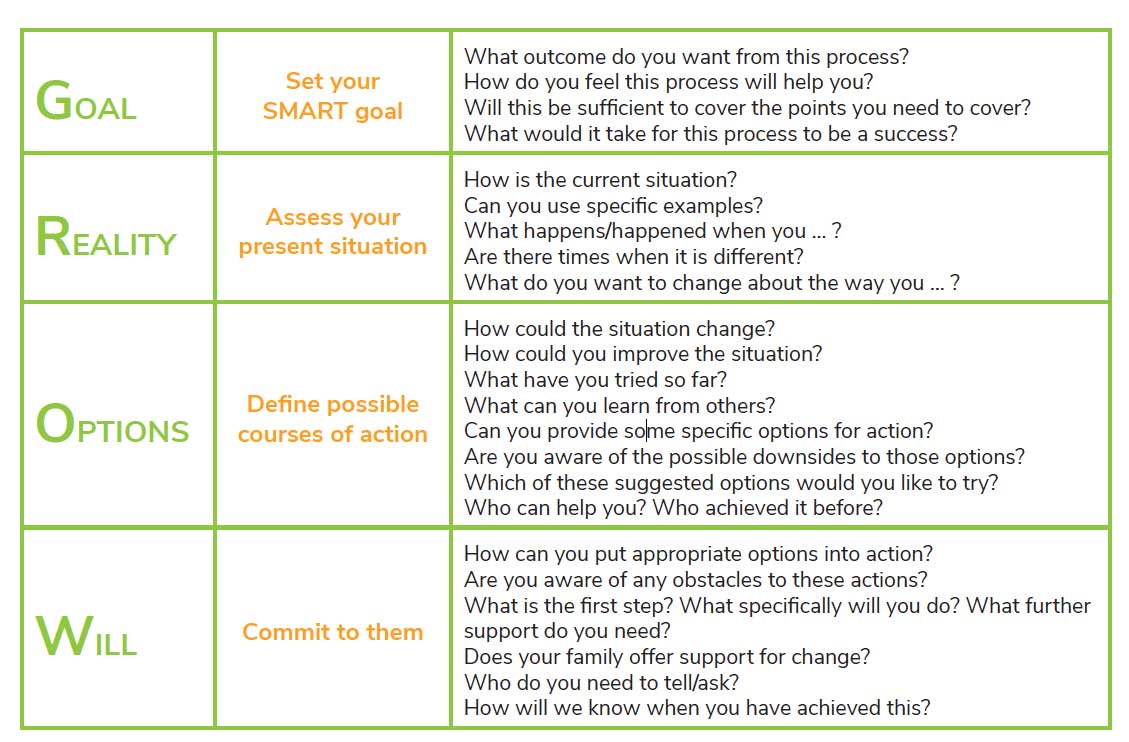
Source: stellarleadership.com
Knowing your motivation to start or further grow your business is necessary to evaluate how to achieve it, consider what is needed to achieve it and to define an action plan with tasks that make it possible:
- Identification of benefits and beneficiaries
- Setting Time Limits
- Identification of major obstacles
- Identification of the skills and knowledge required
- Identification of individuals, groups, organizations and companies with whom to work. If you go to the right people, you will find the right solution.
- Developing the Action Plan
Source: bestcadtips.com/transitioning-a-firm-fromautocad-to-revit/from-point-a-to-point-b/
TO BETTER UNDERSTAND YOUR ENTREPRENEURSHIP OPPORTUNITIES read the REWARD case studies. Find your inspiration discovering for example:
► How to apply what you have learned in other sectors – Marie-Sophy Pujol, FR.
► How to master your existing skills- Andreja Bizjak, SI.
In line with your entrepreneurial skills you can choose from a large diversity of strategic options:
- Create your own business,
- Enlarge the existing business,
- Offer additional services,
- Co-operate with other farmers: enhanced collaboration; collective investments, fusion, partnership,
- Engage more using networking and monitoring of similar businesses.
Rural areas can face certain disadvantages as places for business development. The most important factors tend to be linked to geography, population, infrastructure and resources. So be sure to ground business potential in local realities.
You can use the potential of rural digital hubs: local spaces within rural areas that can be the focal point for the provision of vital digital infrastructure and a range of support services to rural businesses and communities. For example, ENRD Thematic Group on rural digital hubs:
► https://enrd.ec.europa.eu/publications/rural-businesses-rural-digital-hubs_en
The development of critical spirit facilitates any analysis. When considering entrepreneurship opportunities you need also analyze its potential barriers and how to overcome them.

To overcome these barriers don’t forget to:
- Check national and local policies dedicated to Small and Medium Enterprises (SMEs), as well as CAP rural development funding instruments.
- Check available formations; knowledge transfers and Peer to Peer learning.
- Contact national Advisory services for support programmes, etc.
- Look for cooperation opportunities & networking.
- Analyse flexible finances, including new sources of funding (private, venture capital, community funding, etc.), flexible and integrated forms of support ideally provided through a ‘one-stop-shop’.
- Check access to basic services, especially IT and broadband if you want to use them for your marketing.
There are many different ways in which business innovation may be applied in multifunctional farming (MF).
Business innovation is when companies implement new processes, ideas, services, or products with the goal of boosting the bottom line. It could mean launching new and improved products or services (which can lead to higher revenue), making an existing process more efficient, or solving a current business problem (both of which cut down on costs and save time).
The key element of innovation is that it drives revenue for the company.
A farm is a unique entity. Multifunctionality implies the diversification of sources of farm income, allowing farmers to reduce the business risk by relying on alternative sources of revenue. It can range from tourism to various activities set up within the farm e.g. direct selling, restaurants, sports, training about local traditions. In recent years, many farmers have developed didactic and social activities, based on hospitality for students or disadvantaged people. Multifunctionality is directly related both to the sustainability of farms and to the production of services for society. It gives the opportunity to recognize natural, cultural and historical characteristics of the farm.
- Start-ups need to keep with innovation. Having identified your innovation you can apply it also to your start-up if you decide to start one. You can do it as:
- To better understand how to apply innovation and start-up opportunities for your MF activities you can use various supports:
- Looking for typical and atypical functions, products and services of MF you should keep in mind the 10 key drivers of rural change
- Innovation Through Concentration: taking a validated business model and adapting it to new conditions.
- Innovation From Repurposing: taking an existing business model and adopting it to solve new problems.
- Incremental Innovation: creating superior solutions through better features, user experience and/or processes. Creating a competing product with a higher quality, speed and performance without increasing the price while keeping your margins high is an innovation.
In a start-up, different forms of innovation can be combined and progressively evolve to become disruptive or present a radical change in the way we solve a problem.
You can use the 80/20 rule to organise your contribution and plan.
The rule in this case suggests keeping solution fundamentals based on competitor products and user behavior (80%) while differentiating your idea through concentration, repurposing or incremental innovation (20%). The 20% represents your innovation and competitive advantage.
(Source: Forbes article).
- Rural business support: a process of helping businesses to change and innovate in order to adapt to emerging challenges and benefit from new opportunities. These approaches are typically based on a ‘support ecosystem’ incorporating multiple elements and practices such as peer learning, shared workspaces, coaching, mentoring, training, incubators, accelerators, investment finance and shared technical equipment.
- Business accelerators and business incubators: are two types of business-support models that have become particularly well‑known over the past twenty years. These tools differ in important ways in terms of the methods used, target groups and timescales (see table, right).
Source: ENRD
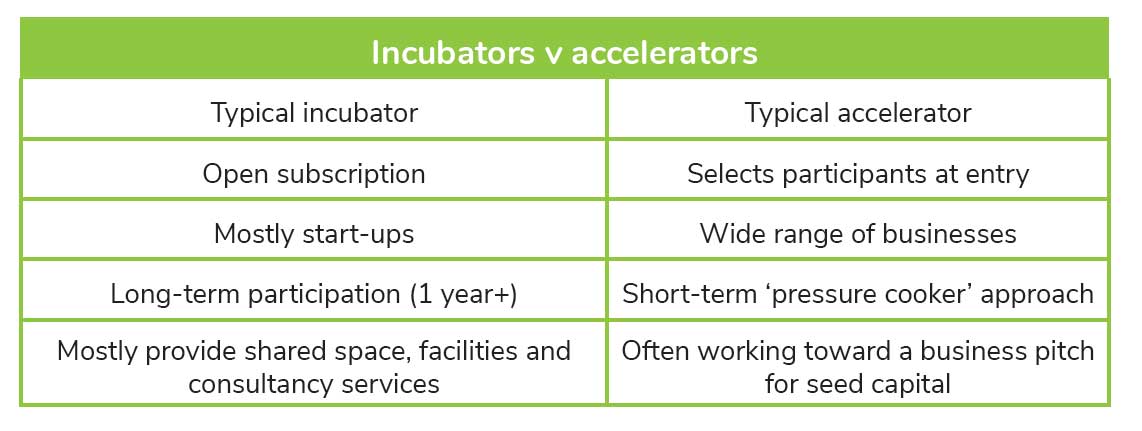
In the post-COVID reality it is even more important to apply any MF farming innovation in a sustainable way, respecting economic, social and environmental goals. There are many tools offered by the European Union to support this; here we present the most important ones:
- CAP Rural Development Programs can offer specific opportunities through:
- LEADER (Measure 19)
- Advisory services (Measure 2)
- The cooperation measure (Measure 16) and the Technical Assistance measure (Measure 20).
- The agricultural European Innovation Partnership (EIP-AGRI) works to foster competitive and sustainable farming and forestry that ‘achieves more and better from less’. It contributes to ensuring a steady supply of food, feed and biomaterials, developing its work in harmony with the essential natural resources on which farming depends. EIP-AGRI Network created a Subgroup on Innovation.
- EU various funds dedicated especially to “research and innovation”; e.g. project LIAISON to unlock the potential of “working in partnership for innovation” in agriculture, forestry and rural business (https://liaison2020.eu/)
- Dedicated networks e.g.: https://www.innovatorsinculturalheritage.eu/registeredarea/innovations
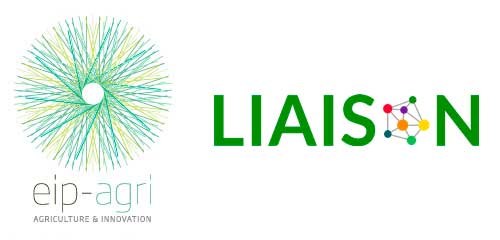
- Additive and distributive manufacturing;
- Drones;
- Driverless cars;
- Cloud computing and internet of things;
- Decentralised energy systems;
- Future of food;
- Future of education;
- Future of health;
- Digital connectivity;
- Shift in values and preferences.
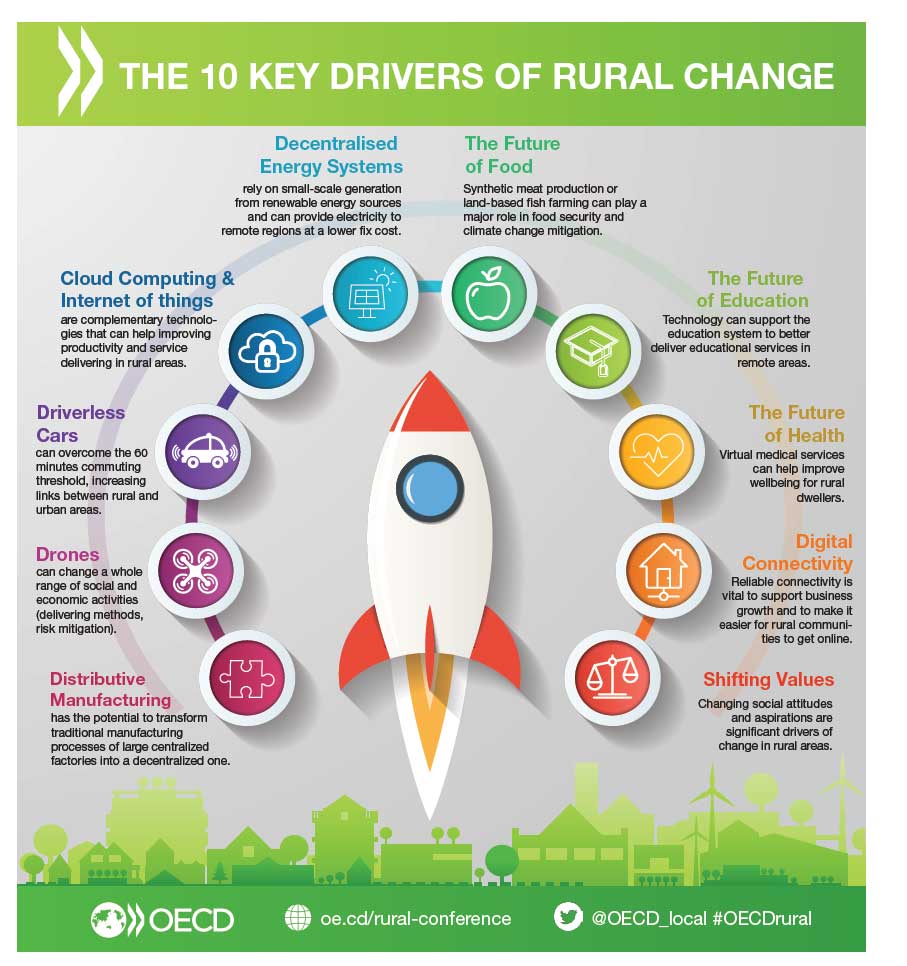
www.oecd.org/rural/rural-development-conference/10-Key-Drivers-Rural-Change.pdf
TO DISCOVER THE “THINKING OUT OF THE BOX” read the REWARD case studies. For example:
There are many different ways in which business innovation may be applied in rural cultural heritage areas. Please read slides 13 and 14 to know more about innovation and start-up concepts.
The diversity of cultural heritage assets, whether tangible (museums, buildings, archaeological sites, archives) or intangible (such as cultural itineraries and events) is a cornerstone in European identity and a catalyst for social inclusion.
Source: https://www.interregeurope.eu/share.
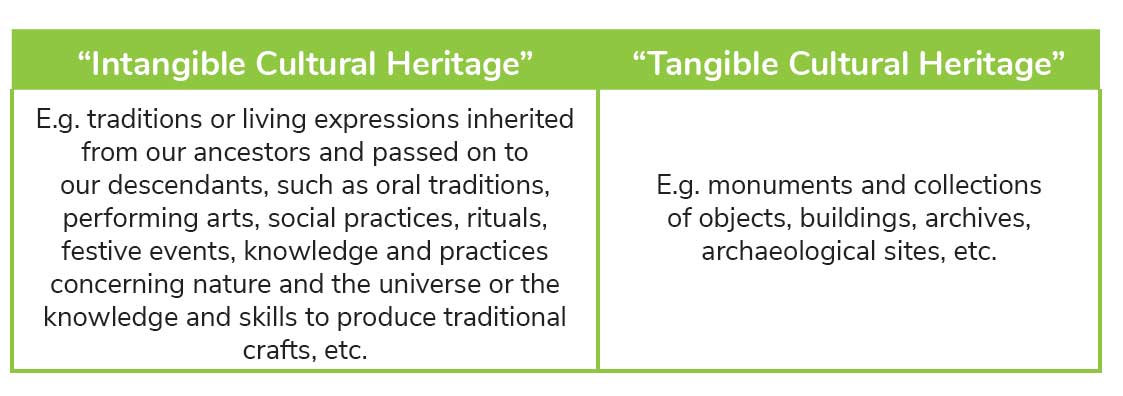
- Rural heritage offers various opportunities for business
- To start applying innovation in your business you need to “think outside of the box”
- There are many tools offered you can use to develop your innovative ideas
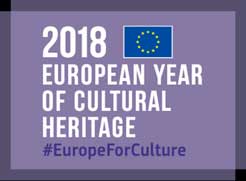 The EU Focus on these topic in particular during the 2018 Year of Cultural Heritage.
The EU Focus on these topic in particular during the 2018 Year of Cultural Heritage.
“We support the Pan-European Charter for rural heritage which promotes sustainable spatial development and the reference in the 2016 Cork Declaration 2.0: “Land management has a key role in the interface between citizens and the environment. Policies must incentivize the delivery of environmental public goods, including the preservation of Europe’s natural and cultural heritage (…) Rural landscapes, the mosaic of natural geological structures and human imprints of agriculture, forestry, lakes, rivers and built settlements provide, perhaps, the greatest cultural heritage there is.” (Source: own initiative opinion,Tom Jones, EESC).
New roles where innovation can be applied can focus on:
- Farm open days, school rural visits, shows, craft and other fairs and cultural festivals to build bridges between rural and urban citizens through cultural projects,
- Sustainable tourism, to facilitate urban citizens to appreciate the cultural values of rural areas and increasingly opt for rural homes and work in remoter settlements,
- Marketing of rural cultural produce, including gastronomic heritage, to promote geographically-branded status protected, giving assurance on quality and traceability to citizens.
Here some examples to inspire you.
- “New partnerships - St. Francis Way as an innovative example from Italy”
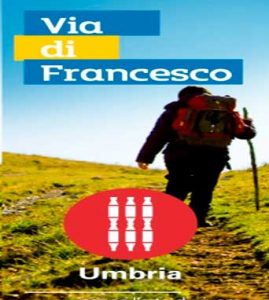 For the Umbria region, the itinerary valorises cultural heritage (tangible and intangible) while encouraging sustainable, inclusive, slow tourism. An additional benefit is the development of innovative, participatory governance of cultural heritage assets, with stakeholders from public and private sectors and actors from civil society organisations, as indicated on their website.
For the Umbria region, the itinerary valorises cultural heritage (tangible and intangible) while encouraging sustainable, inclusive, slow tourism. An additional benefit is the development of innovative, participatory governance of cultural heritage assets, with stakeholders from public and private sectors and actors from civil society organisations, as indicated on their website.
► Source: www.viadifrancesco.it/en - Products itineraries like “Wine roads” and online wine tasting
 Gastronomic itineraries to discover the local food traditions; built around rural traditions that are based on cultural centres and museums with the use of new IT tools to allow “online” meetings with wine producers to present and taste their products.
Gastronomic itineraries to discover the local food traditions; built around rural traditions that are based on cultural centres and museums with the use of new IT tools to allow “online” meetings with wine producers to present and taste their products.
► Source: www.welcomingestateswebsite.com
- CAP Rural Development Programs can offer specific opportunities through:
- LEADER (Measure 19)
- Advisory services (Measure 2)
- The cooperation measure (Measure 16) and the Technical Assistance measure (Measure 20).
- EU funded networks & communities:
- “Innovators in cultural heritage” www.innovatorsinculturalheritage.eu
- www.cultrural.eu, etc
- Dedicated private organisations or networks:
- European Historic Houses: www.europeanhistorichouses.eu
- EuropaNostra: www.europanostra.org, etc
TO DISCOVER THE “THINKING OUT OF THE BOX” read the REWARD case studies.
► Restart of the local label – Jacqueline Cottier, FR.
and many others to inspire you!
We are facing the metamorphosis of rural areas. The era of globalisation is also transforming the countryside in Europe, including demographic phenomena and changes in the economic structure. This also includes institutional changes as governments have a less dominant role in the countryside. Given the technological advances and intensified competition in agricultural markets, it is crucial to find new ways for the business. Source: OECD, 2019
Innovation is a must for all regions, whether rural or not.
As an entrepreuner you will need to identify:
- your personal characteristics;
- the characteristics of the farm enterprise;
- the activities and processes undertaken on your farm and
- the specific needs of the farm enterprise to analyze how to apply it to use it to its full extent.
Don’t forget to look for some inspiration within the REWARD case studies!
A farm is a unique entity. Even if the process of a business innovation is very individual, have you made a list of potential starting points allowing you to diversify sources of farm income to fully use its possible multifunctionality? Add to that list 3 potential support tools and best practises you should check for further inspiration.
Click on the button below to start the Self-assessment.
- Les nouveaux cerealiers ; https://www.youtube.com/watch?v=BEvCU0wxJLo&feature=youtu.be
- “If we combine definitions of entrepreneurship by Jones and Sakong, 1980; Timmons, 1989; Stevenson, et al., 1985”. Tyson, Petrin, Rogers, 1994, p. 2-3
- “Discover Your True North,” Bill George.
- FAO, Section I: Entrepreneurship and supporting institutions: an analytical approach; http://www.fao.org/3/W6882e/w6882e02.htm
- The 5 Motivations That Drive People to Choose Entrepreneurship; https://www.entrepreneur.com/article/249417
- Hisrich and Brush, 1984.
- GEM, Reynolds, Camp, Bygrave, Autio, & Hay, 2001.
- ENRD Thematic Group on rural digital hubs, 2020.
- DETERMINANTS OF RURAL ENTREPRENEURSHIP IN VIEW OF LITERATURE; KSOW; http://ksow.pl/fileadmin/user_upload/ksow.pl/pliki/BalticSeaStrategy/publikacje/5_Determinants__Jeziorska-Biel_Sudra.pdf
- How Your Startup Idea Can Be Innovative; https://www.forbes.com/sites/abdoriani/2019/10/23/how-your-startup-idea-can-be-innovative/#2c697d7f1dfb
- The contribution of Europe’s rural areas to the 2018 Year of Cultural Heritage ensuring sustainability and urban/rural cohesion - own-initiative opinion - Rapporteur: Tom JONES, EESC
- Ref. 1: https://ied.eu/project-updates/how-an-entrepreneurial-idea-can/
- Ref. 2: www.fao.org/3/W6882e/w6882e02.htm
- Ref. 3: https://elearninginfographics.com/3-types-of-motivation-infographic/
- Ref. 4: www.forbes.com/sites/martinzwilling/2015/08/27/6-top-motivations-that-drive-the-best-entrepreneurs/#20a51f4e26ff
- Ref. 5: bestcadtips.com/transitioning-a-firm-fromautocad-to-revit/from-point-a-to-point-b/
- Ref. 6: www.forbes.com/sites/quora/2017/09/11/what-are-the-most-important-skills-entrepreneurs-need/#30e57aeb106c
- Ref. 7: www.toolshero.com/personal-development/smart-goals/
- Ref. 8: www.gemconsortium.org/about/gem/5
- Ref. 9: https://career.uconn.edu/blog/2016/10/20/developing-long-term-career-goals/
- Ref. 10: https://stellarleader.com/
- Ref. 11: https://enrd.ec.europa.eu/sites/enrd/files/s4_rural-businesses-factsheet_bus-accelerators.pdf
- Ref. 12: www.slideshare.net/OECD-regions/innovation-in-rural-areas
- Ref. 13: https://liaison2020.eu/
- Ref. 14: www.innovatorsinculturalheritage.eu/registeredarea/innovations
- Ref. 15: www.startus-insights.com/innovators-guide/agritech-innovation-map-reveals-rising-technologies-startups/
- Ref. 16: www.oecd.org/regional/ruraldevelopment.htm
- Ref. 17: www.interregeurope.eu/share/
- Ref. 18: https://ec.europa.eu/eip/agriculture/en/european-innovation-partnership-agricultural
- Ref. 19: www.innovatorsinculturalheritage.eu/registeredarea/innovations
- Ref. 20: www.welcomingestateswebsite.com
- Ref. 21: www.viadifrancesco.it/en/
- Ref. 22: www.cultrural.eu
- Ref. 23: www.ted.com








